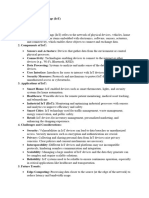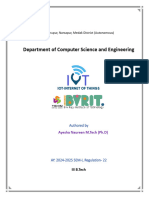0 ratings0% found this document useful (0 votes)
2 viewsThe Internet of Things (IoT)
The Internet of Things (IoT)
Uploaded by
BeaCopyright:
© All Rights Reserved
Available Formats
Download as PDF, TXT or read online from Scribd
The Internet of Things (IoT)
The Internet of Things (IoT)
Uploaded by
Bea0 ratings0% found this document useful (0 votes)
2 views2 pagesOriginal Title
The_Internet_of_Things_(IoT)
Copyright
© © All Rights Reserved
Available Formats
PDF, TXT or read online from Scribd
Share this document
Did you find this document useful?
Is this content inappropriate?
Copyright:
© All Rights Reserved
Available Formats
Download as PDF, TXT or read online from Scribd
Download as pdf or txt
0 ratings0% found this document useful (0 votes)
2 views2 pagesThe Internet of Things (IoT)
The Internet of Things (IoT)
Uploaded by
BeaCopyright:
© All Rights Reserved
Available Formats
Download as PDF, TXT or read online from Scribd
Download as pdf or txt
You are on page 1of 2
The Internet of Things (IoT)
Chapter 1: Introduction to IoT
What is IoT?
The Internet of Things (IoT) refers to the interconnected network of devices and
objects embedded with sensors, software, and other technologies to collect and
exchange data over the internet. IoT enables smarter cities, homes, and industries.
Chapter 2: Components of IoT
1. Devices and Sensors:
IoT devices include everyday objects like smart thermostats, wearables, and
industrial machines equipped with sensors to collect data.
2. Connectivity:
IoT devices connect through various communication protocols, including Wi-Fi,
Bluetooth, and cellular networks, facilitating data transfer.
Chapter 3: IoT Architecture
1. Edge Computing:
Edge computing processes data near the source of generation, reducing latency
and bandwidth use. This is crucial for real-time applications like autonomous
vehicles.
2. Cloud Computing:
Cloud platforms store and analyze data collected from IoT devices, providing
scalable solutions for data management and processing.
Chapter 4: Applications of IoT
1. Smart Homes:
IoT enables automation and remote control of home devices, enhancing
convenience and energy efficiency.
2. Healthcare:
In healthcare, IoT devices monitor patients' vital signs and transmit data to
healthcare providers for real-time monitoring and intervention.
Chapter 5: Challenges in IoT
1. Security Vulnerabilities:
IoT devices are often targets for cyberattacks due to inadequate security measures.
Ensuring device security is critical to protect sensitive data.
2. Interoperability:
The lack of standardization among IoT devices can hinder communication and
integration, creating challenges in deployment and management.
Chapter 6: Future Trends in IoT
1. 5G Connectivity:
The rollout of 5G networks will enhance IoT capabilities by providing faster speeds
and more reliable connections, enabling more devices to connect seamlessly.
2. Artificial Intelligence Integration:
Combining AI with IoT will enable smarter decision-making and automation,
allowing devices to learn from data and improve their functionality.
Chapter 7: Best Practices for IoT Implementation
1. Prioritize Security:
Implement strong security protocols, including encryption, regular updates, and
access controls, to protect IoT devices and data.
2. Focus on Scalability:
Choose IoT solutions that can scale with your organization’s growth, accommodating
an increasing number of devices and data.
Chapter 8: Conclusion
The Internet of Things is transforming how we interact with the world around us,
creating new opportunities for efficiency and innovation. Addressing security and
interoperability challenges will be key to realizing the full potential of IoT.
You might also like
- Detailed Solutions For IoTDocument17 pagesDetailed Solutions For IoTdevanshilavanivaNo ratings yet
- Internet of ThingsDocument3 pagesInternet of ThingsHari hara Sudhan .MNo ratings yet
- Internet of Things (IoT)Document2 pagesInternet of Things (IoT)vixela8122No ratings yet
- Notes IOTDocument2 pagesNotes IOTDilip RanjanNo ratings yet
- EI - Unit VDocument31 pagesEI - Unit VRohan WaghNo ratings yet
- U1Document2 pagesU1Atharva InamdarNo ratings yet
- Unit 1 Introduction To Internet of Things NotesDocument13 pagesUnit 1 Introduction To Internet of Things NotesVaibhav SrivastavaNo ratings yet
- The Internet of ThingsDocument11 pagesThe Internet of Thingsbalic63297No ratings yet
- The Internet of ThingsDocument5 pagesThe Internet of Thingsitsjoker786hereNo ratings yet
- UNIT1 IoTDocument21 pagesUNIT1 IoTkashifreza2000No ratings yet
- CHAPTER 1 OrganizedDocument6 pagesCHAPTER 1 OrganizedJayanth ReddyNo ratings yet
- Ict AssignmentDocument7 pagesIct Assignmentkalucaku2580No ratings yet
- Unit 1 1Document19 pagesUnit 1 1AbinayaNo ratings yet
- IOT Security 7Document19 pagesIOT Security 7SatyajitNo ratings yet
- Simran PPT 92 IoTDocument32 pagesSimran PPT 92 IoTSeema ThakurNo ratings yet
- Title: A Discussion On The Internet of Things: Potential, Challenges, and Future ProspectsDocument2 pagesTitle: A Discussion On The Internet of Things: Potential, Challenges, and Future ProspectsRoudha HassanNo ratings yet
- Chapter 4 - Internet of ThingsDocument36 pagesChapter 4 - Internet of Thingssurafelfisseha27No ratings yet
- Es&iot Unit 3 NotesDocument28 pagesEs&iot Unit 3 NotesanniepersiasNo ratings yet
- UNIT 1 IoTDocument30 pagesUNIT 1 IoTraparthisusmithaNo ratings yet
- Unit-1 Iot (Q&a)Document24 pagesUnit-1 Iot (Q&a)it.deprt2024No ratings yet
- IotDocument25 pagesIotAnshika RaiNo ratings yet
- Presentation 3 (2)Document24 pagesPresentation 3 (2)Anshika RaiNo ratings yet
- An Overview of The Internet of Things (Iot) and Iot SecurityDocument8 pagesAn Overview of The Internet of Things (Iot) and Iot SecuritydavidNo ratings yet
- EmgTech Chapter 4Document30 pagesEmgTech Chapter 4kevin 11No ratings yet
- Chapter 4 IoTDocument22 pagesChapter 4 IoTmeti bekeleNo ratings yet
- 227 Block-3Document33 pages227 Block-3shivam saxenaNo ratings yet
- Internet of Thing1Document5 pagesInternet of Thing1ehoxha22No ratings yet
- IOT InternetOFThingsDocument69 pagesIOT InternetOFThingsR RahulNo ratings yet
- IoT REPORT Raj Deep YadavDocument34 pagesIoT REPORT Raj Deep YadavRaj DeepNo ratings yet
- IOT PyqDocument35 pagesIOT Pyqshivamgajjar1545No ratings yet
- Internet of ThingsDocument64 pagesInternet of ThingsSriram SudheerNo ratings yet
- Chapter-2 IoT FinalDocument15 pagesChapter-2 IoT FinalPutta SwamyNo ratings yet
- GokuDocument7 pagesGokukalucaku2580No ratings yet
- Fiot Unit 1Document94 pagesFiot Unit 1HARSHINI RAVVANo ratings yet
- Internet Od ThingsDocument13 pagesInternet Od ThingsmeghnagoudvaskarNo ratings yet
- Introduction To IoTDocument11 pagesIntroduction To IoTOliver Benjamin100% (2)
- Emerging Chapter 4Document21 pagesEmerging Chapter 4neguyared837No ratings yet
- Introduction To Emerging Technology (EMTE1012) The Internet of Things Compiled byDocument25 pagesIntroduction To Emerging Technology (EMTE1012) The Internet of Things Compiled byBiyaNo ratings yet
- IOT AND WSM MODULE 1 AND 2 NOTESDocument37 pagesIOT AND WSM MODULE 1 AND 2 NOTESs8102003No ratings yet
- Chapter FourDocument17 pagesChapter FourAbdikadar MohamedNo ratings yet
- IOT AND WSM MODULE 1 AND 2 NOTESDocument37 pagesIOT AND WSM MODULE 1 AND 2 NOTESs8102003No ratings yet
- Moizuddin Shaikh IOT AsgnmtDocument12 pagesMoizuddin Shaikh IOT Asgnmtcontact.moizuddinNo ratings yet
- MS Unit 1 BDocument37 pagesMS Unit 1 B12112004itNo ratings yet
- Lecture 1Document20 pagesLecture 1Hadji AbdullahNo ratings yet
- Chapter Four IoTDocument47 pagesChapter Four IoTadugnamezgebu135No ratings yet
- IoT Unit I - OverviewDocument27 pagesIoT Unit I - OverviewGsNo ratings yet
- Question 1Document5 pagesQuestion 1Bhavesh GharatNo ratings yet
- Chapter-2 IoT FinalDocument16 pagesChapter-2 IoT FinalPutta SwamyNo ratings yet
- Chapter1-IoT EcosystemDocument31 pagesChapter1-IoT EcosystemhmarunankNo ratings yet
- Communication in Iot Devices: Dipak Wajgi, Jitendra V. Tembhurne, Rakhi Wajgi, and Tapan JainDocument24 pagesCommunication in Iot Devices: Dipak Wajgi, Jitendra V. Tembhurne, Rakhi Wajgi, and Tapan JainaboodahmedfatahNo ratings yet
- Iot - Winter 2022 - SolutionDocument43 pagesIot - Winter 2022 - Solutionnextin.llpNo ratings yet
- IoT PIDocument59 pagesIoT PIsm2nictNo ratings yet
- Chapter:1 Introduction To Internet of Things (Iot)Document16 pagesChapter:1 Introduction To Internet of Things (Iot)kanaiya valviNo ratings yet
- Week 1 Introduction To IoTDocument17 pagesWeek 1 Introduction To IoTVince AlcazarNo ratings yet
- Internet of Things MaterialDocument117 pagesInternet of Things MaterialAyesha Naureen KhanNo ratings yet
- QB - IoT (AutoRecovered)Document13 pagesQB - IoT (AutoRecovered)Sujit ThoratNo ratings yet
- IoT Unit IDocument72 pagesIoT Unit Iaakaankshaagupta20No ratings yet
- Internet of Things (Iot) : Definitions, Challenges and Future ApplicationsDocument7 pagesInternet of Things (Iot) : Definitions, Challenges and Future ApplicationsKHUSHAL CHAUHANNo ratings yet
- ch4 Internet of ThingsDocument25 pagesch4 Internet of ThingsBini JaminNo ratings yet
- Cost Based OptimizerDocument20 pagesCost Based OptimizerBeaNo ratings yet
- Implementing Two Node RAC FinalDocument69 pagesImplementing Two Node RAC FinalBeaNo ratings yet
- Rac ManagefinalDocument53 pagesRac ManagefinalBeaNo ratings yet
- Deleting Cluster Node From Oracle Real Application Cluster EnvironmentDocument27 pagesDeleting Cluster Node From Oracle Real Application Cluster EnvironmentBeaNo ratings yet
- Flashback QueryDocument15 pagesFlashback QueryBeaNo ratings yet
- Configuring Archivelog Under RACDocument25 pagesConfiguring Archivelog Under RACBeaNo ratings yet
- Oracledbafinal1Document197 pagesOracledbafinal1BeaNo ratings yet
- Automatic Workload RepositoryDocument9 pagesAutomatic Workload RepositoryBeaNo ratings yet
- JIRA Tutorial: A Complete Guide For BeginnersDocument5 pagesJIRA Tutorial: A Complete Guide For BeginnersBea0% (3)
- Adding A RAC NODE: DB Experts Basavraju 1Document22 pagesAdding A RAC NODE: DB Experts Basavraju 1BeaNo ratings yet
- Postman Tutorial For Beginners With API Testing ExampleDocument5 pagesPostman Tutorial For Beginners With API Testing ExampleBeaNo ratings yet
- Security Q&aDocument10 pagesSecurity Q&agjenerrick mateoNo ratings yet
- Persistant Data ManagementDocument2 pagesPersistant Data ManagementMikiyas AbebeNo ratings yet
- SSEC SSG 2021.1 PDFDocument512 pagesSSEC SSG 2021.1 PDFLyu SeyNo ratings yet
- Trifid CipherDocument3 pagesTrifid Cipherxativiy256No ratings yet
- 7 Way Instagram HackDocument3 pages7 Way Instagram HackDivyagupta gupta100% (1)
- KES Cloud DatasheetDocument2 pagesKES Cloud DatasheetFarid AhmadNo ratings yet
- Automated Teller Machine ATM Frauds and SecurityDocument15 pagesAutomated Teller Machine ATM Frauds and SecurityNishank JindalNo ratings yet
- Site Security Assessment GuideDocument23 pagesSite Security Assessment GuideChloie Guevarra100% (2)
- CC Unit-1Document17 pagesCC Unit-1sreeharidas2124No ratings yet
- React Fortify ScanDocument11 pagesReact Fortify Scanakash guptaNo ratings yet
- Assignment-1: Incident Response PlanDocument3 pagesAssignment-1: Incident Response PlanShishir KumarNo ratings yet
- Proofpoint Email Protection PresentationDocument54 pagesProofpoint Email Protection Presentationsimolotfy.medNo ratings yet
- Jenkins Installation On AWS CloudDocument5 pagesJenkins Installation On AWS CloudDDNo ratings yet
- Comments On National Cybersecurity Strategy DraftDocument10 pagesComments On National Cybersecurity Strategy DraftNOAH ABALONDENo ratings yet
- Sai Security Services - JDDocument2 pagesSai Security Services - JDVaishnavi MithapalliNo ratings yet
- TP3 Ghazi Ben YahyaDocument12 pagesTP3 Ghazi Ben Yahyakaw birthdayNo ratings yet
- Red Hat JBoss Enterprise Application Platform-6.4-How To Setup SSO With SAML v2-En-USDocument42 pagesRed Hat JBoss Enterprise Application Platform-6.4-How To Setup SSO With SAML v2-En-USKirsonNo ratings yet
- Sample Penetration Testing Report TemplateDocument37 pagesSample Penetration Testing Report TemplateMarcos Gomez100% (1)
- RP Hacking Skills ShortageDocument20 pagesRP Hacking Skills ShortageRobin RichardsonNo ratings yet
- Hipaa TrainingDocument7 pagesHipaa TrainingJosue MoralesNo ratings yet
- ISAA Final ReportDocument22 pagesISAA Final ReportSai AnirudhNo ratings yet
- A Survey On Wireless Security: Technical Challenges, Recent Advances, and Future TrendsDocument39 pagesA Survey On Wireless Security: Technical Challenges, Recent Advances, and Future Trendsprasad shingneNo ratings yet
- Cyber Attacks and DefencesDocument15 pagesCyber Attacks and DefencesMoAzZam rAjpOotNo ratings yet
- IP SpoofingDocument37 pagesIP SpoofingDilan D Almeida100% (2)
- h12 711 SecurityDocument59 pagesh12 711 SecuritybezatibeNo ratings yet
- Social EngineeringDocument11 pagesSocial EngineeringDato LesherNo ratings yet
- ch08 MisDocument48 pagesch08 MisDalal KwtNo ratings yet
- Bba-Financial-Services Syllabus 24020181011.102258 PDFDocument48 pagesBba-Financial-Services Syllabus 24020181011.102258 PDFMoni MonicaNo ratings yet
- What Is FootprintingDocument5 pagesWhat Is Footprintinganon_949828493No ratings yet
- Group 3 ASM 01 02Document22 pagesGroup 3 ASM 01 02Bob LongNo ratings yet




































































































